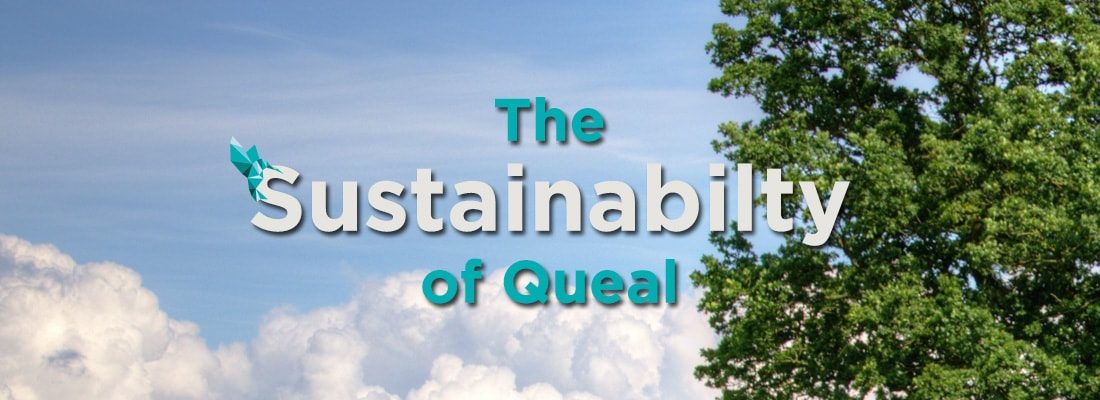
The Sustainability of Queal
Queal is a quick meal, we can all agree on that. What many people ask us is: Are you also sustainable? This question is more difficult to answer. To fully answer this question we will dive into the definition of sustainability, Queal’s ingredients, and our environmental impact. We can conclude that Queal is a sustainable food source, but there are improvements to be made in the supply chain.
The Definition of Sustainability
Sustainability is the ability to continue doing something over a long span of time. In food production this means that with the current resources you should be able to produce the same things the next year. For instance, if you are using too much water or when you create a nutrient deficiency in the ground, you’re not being sustainable. Only when you can go on indefinitely are you being sustainable.
When we look at the sustainability of Queal, we have to compare it to different types of food. Is the production of Queal something that has a better environmental impact than meat or fruits? Therefore, we will look at the sustainable diet. We will look at the impact of Queal on the environment, but also how it will affect people.
The definition of a sustainable diet:
“Those diets with low environmental impacts which contribute to food and nutrition security and to healthy life for present and future generations. Sustainable diets are protective and respectful of biodiversity and ecosystems, culturally acceptable, accessible, economically fair and affordable; nutritionally adequate, safe and healthy; while optimising natural and human resources.” source
A sustainable diet should be good for both the environment and the consumer, and should be able to be repeated in the future.
The Sustainability of Queal’s Main Ingredients
Queal consists of 15 ingredients (not counting the individual vitamins and mineral). Of these ingredients, four make up the bulk of the powder. These are oats (30%), maltodextrin (25%), whey protein (25%), and soy (10%). Together these ingredients make up about 90% of the powder in Queal. Note: these numbers are rounded and all information about ingredients and nutrients can be found here.
Let’s break down these four main ingredients and their impact on the environment and us humans.
Oats as a Sustainable Crop
The oats we use for our products are sourced from the UK and Finland. The general consensus with oats is that they are very sustainable. They require low-input farming and can be planted in rotation with other crops so that they don’t drain the soil. Two crops with which oats are routinely rotated are corn and soy beans (both also in Queal), which eliminates the need for corn root worm insecticides. Oats in a crop rotation, therefore decrease the need for chemical insecticides.
In contrast to corn, oats need less water and don’t deplete underground water aquifers. Because oats are a dense crop, they also help prevent soil erosion. Oats therefore also consume less water than other crops.
A by-product of making oats (for people) are the hulls they leave behind. Instead of leaving them behind, they are now being used as an alternative source of energy. It’s a clean source of energy and is actually providing energy to universities and houses in Midwest America. When not used for energy the hulls are an excellent fibre source for animal feed.
Oats are also sustainable for people. They form the basis of many foods like your morning (healthy) cereals, bread, and wraps. At Queal we use oats that are held to the highest standards for Mycotoxines, heavy metals, 3-MCPD, dioxins and PCBs, Polycyclic Aromatic Hydrocarbons, colourings and pesticides. And like all other ingredients, they are free from GMOs.
The Questionable Sustainability of Corn
Maltodextrin is commonly made from corn starch, rice starch, or potato starch. We use maltodextrin that is made from corn starch. We use maltodextrin because it’s a moderately fast carbohydrate from a natural source. But is it also sustainable?
To answer that, we have to look at the sustainability of corn (also called maize). Corn is one of the most common crops there are in the world. The industry for corn is as big as $67 billion annually. And with such a big industry there are certainly problems. In the United States there is widespread unsustainable use of water through irrigation and high nitrogen use.
Corn production in the US
In the US, 87% of irrigated corn is grown in regions where there is a water shortage. This leads to declines in groundwater levels around those areas. This also leaves the corn production at the mercy of extreme weather and climate change. When there are changes in the climate it will have an immediate effect on the production of corn.
Corn also uses the most fertiliser of all major crops. In 2010, this was a total of 9.5 million tons of nitrogen, phosphorus, and potash. One of the main reasons for the ‘dead zone’ in the Gulf of Mexico is nitrogen run-off from cornfield. source
This means that corn, at the moment, is anything but sustainable. 38% of the corn production is used for animal feed, another 35% is used for ethanol production, and only 10% is used for food ingredients. When a dependency on the first two categories can be mitigated (by eating less meat and using less ethanol) the pressure on corn (and the land underneath) can be significantly decreased.
In Europe, the problems are similar but at a smaller scale. Corn is mostly used as feed for animals (for meat consumption) and these animals are reared in places where the land is right for them. This, unluckily, doesn’t mean that the land is perfect for growing corn. To combat the impact on the environment there is strict legislation in Europe. But as in the US, we have to be vigilant and make sure that corn won’t drain the soil.
Here in The Netherlands corn is successfully grown, despite being a heat-loving crop (such as soy). This is done by selective breeding (read: not GMOs) of corn. This means that the local corn here is adjusted to the Dutch climate and can survive here. Corn still uses a lot of water, but not so much that it’s unsustainable (like in some states in the US).
For humans corn is one of the most sustainable crops out there. It’s rich in starch, proteins, vitamin B, vitamin C, and carbohydrates. It contains a high percentage of fibre (something most people are deficient in), potassium, and antioxidants. A sustainable diet should therefore definitively contain corn.
Whey Protein – the By-Product of Cheese
Everyone who has lifted some weights knows what whey protein is. Not everybody knows how whey protein is made. Whey is a by-product of the cheese making process. When casein is extracted from milk to make cheese, the liquid left behind is called whey.
Sometimes this is dumped, or sprayed, on land to be used for growing crops. This can cause problems with run-off like the growing of aquatic plants. Instead of letting whey go to waste, it can be used to make a large range of products, from whey cheese and protein powders, to being used in the making of fortified wines and gins. In this way, whey has a positive impact on the environment; it prevents loss in the supply chain and is a rich source of protein.
The overall contribution of the global milk (and cheese & whey) production, processing, and transportation to global CO2 emissions is 2.8%. Per kg of milk this is 1.5 kg CO2-eq in Western Europe. Whey is a large percentage of milk when you look at the mass, but a lower percentage when you look at the value. If we look at whey and cheese as end products from milk, then per protein we can say that whey and cheese are both equally good/bad.
Whey comes from a process that has a large CO2 footprint, but at the same time it’s a waste product when you convert milk into cheese. This waste product is now being used and that, in my eyes, qualifies as sustainable.
As a source of protein, whey is a very sustainable source. It has a full amino acid profile and therefore provides most of the building blocks our muscles need to flourish. Many people, from bodybuilders to the average gym goer, use whey protein to make sure they have enough protein in their diet.
Soy Production is Unsustainable at a Global Scale
The biggest problem with soy is the unsustainable production that is taking place around the world. In South-America, soy is one of reasons for the disappearance of tropical forests and unique savannas. Many species of animals and nature have been lost. At the same time, many people are displaced due to the production of soy. Because soy is not very labour intensive, the production of soy also leads to a loss of jobs.
When you look at the environmental impact of soy you can paint a better picture. Soy is good for soil because it binds nitrogen to the ground, thereby increasing the yield for the next crop the next year (like in the rotation mentioned with oats production).
Within Europe there is still space enough to produce soy. This is land that is not being used right now and therefore won’t displace anyone. Today there are 400.000 hectares of soy production in Europe. We at Queal buy from here because we want to know the source of all our ingredients. The global problem with soy is that it’s cheaper to make in South America. If the yield of soy could be higher, maybe more of it would be made in Europe and other places where the societal impact would be lower.
Soy beans contain large amounts of Manganese, Selenium, Copper, Potassium, Phosphorus, Magnesium, Iron, Calcium, Vitamin B6, and other micro-nutrients that are essential daily recommended nutrients. Soy is a good source of protein, but less concentrated than eggs or meat. In a normal diet soy can provide extra carbs, fats, and protein that form the basis of a sustainable diet.
Queal is generally a Sustainable Food
Three of the four basic ingredients of Queal are sustainable crops (in Europe). Corn may use a lot of water, but hasn’t led to droughts like in the United States. The environmental impact of Queal is not too big. And if you compare Queal to other products, like meats, it has a much smaller water footprint. Please also have a look at our other blogs related to sustainability.
Of course we only looked at our definition of sustainability and the effects that Queal has on these factors. What do you think about Queal, the ingredients, and other things we eat every day? Is Queal one of the better products in your kitchen, or are there other products that are even more sustainable? Let us know in the comments below!

No Comments